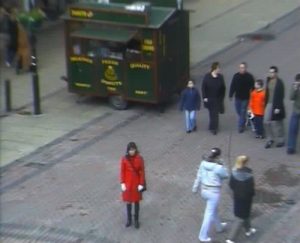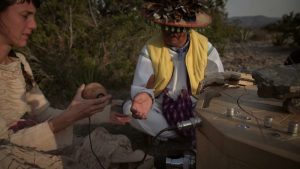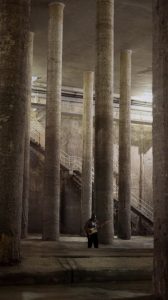Simon Faithfull’s exhibition Gravity Sucks and his recent talk at the British Film Institute focuses largely around his examination of that most elementary of forces we experience. What Wikipedia calls a “consequence of the curvature of spacetime which governs the motion of inertial objects” and what we call gravity.
In what has come to be sometimes called Gravity Art, there is actually a couple of artists who have chosen to use it as their medium, often in somewhat beautiful yet futile actions, “heroic failures”. Among these however, there’s different directions of movement, namely down (submission) and up (escape).
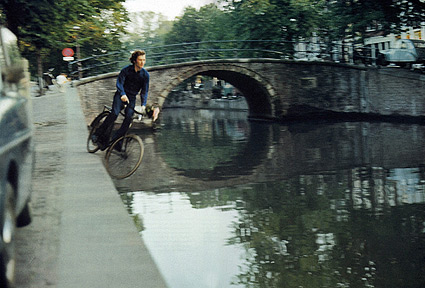 Bas Jan Ader, Fall II (Amsterdam) 1970, © Mary Sue Ader-Andersen
Bas Jan Ader, Fall II (Amsterdam) 1970, © Mary Sue Ader-Andersen
The most relevant of the down-camp would probably be the late Dutch-Californian artist Bas Jan Ader whose body of work only contains a few pieces but who has significantly gained in importance as people have been re-discovering him over the last few years. Ader’s gravity-related work focuses on the “The artist’s body [and the way that] gravity makes itself its master” as he put it when his films Fall I (Los Angeles) and Fall II (Amsterdam) were being shown in Düsseldorf in 1971. He used the most basic elements – an omnipresent force and his own body.
His work, however, as his friend Rene Daalder’s documentary Here Is Always Somewhere Else convincingly shows, is seeded with references to his family history and his personal confusion that might have resulted from that and which peaked in his mysterious disappearance at sea during his final piece In Search of the Miraculous in 1975. In Fall 1 (Los Angeles) we see him on the roof of the house he and his wife were living in, sitting on a chair. Like in another performance, which refers to the night when Nazi soldiers forced his family out of their house in the Netherlands, a piece of the domestic environment becomes part of the performance. Ader leans over, loses balance, tumbles across the roof and crashes into the bushes in front of the porch while the chair comes to a halt still on the roof.
Bas Jan Ader, Fall I (Los Angeles) 1970, © Mary Sue Ader-Andersen
Chairs it seems, have a special significance in relation to Gravity Art, possibly because they are a device which in a way suspends us in mid-fall, in a pose we call sitting. They also represent a highly familiar artifact and thus create a link between the universal force of gravity and the utterly domestic.
In the work of Simon Faithfull, who perfectly represents the opposite direction of movement, they play an even more obvious role as he explicitly uses them as a means for both him and the audience to project themselves into what he calls Escape Vehicles. He says the vehicles allow “[to] imagine occupancy of the seat while at the same time acknowledging that it is incapable of the pronouncement made within its title.” He has built a series of them since the mid-1990s, the most recent being no.6 which was commissioned by Arts Catalyst in 2004.
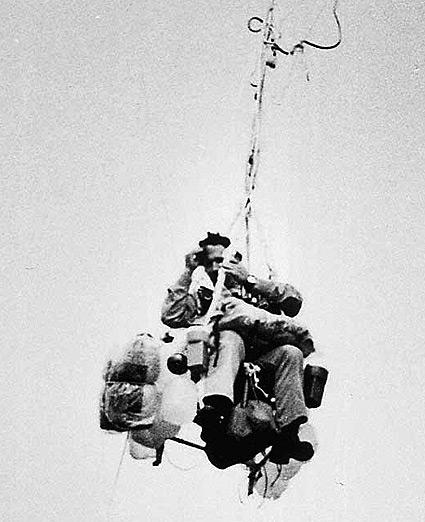 “Lawnchair” Larry Walters, taking flight on July 2nd 1982
“Lawnchair” Larry Walters, taking flight on July 2nd 1982
This latest one, which the accompanying text to the exhibition at the BFI calls an “alarming” success, partly takes its inspiration from the famous flight of Lawnchair Larry. In the summer of 1982, because “a man can’t just sit around”, Walters attached a great number of weather balloons to a chair and – somewhat accidentally – shot off to an altitude of 11,000 feet and into the controlled airspace of LAX. (Don’t miss the original NBC news coverage) Equipped with a pellet gun, sandwiches, beer and having dropped his glasses. His often-ridiculed trip could well be called the ultimate combination of the everyday and the heroic aspiration to “lose the shackles of gravity”.
In the case of Escape Vehicle no.6, the chair is empty, but the experiment is not any less successful, it rose to an altitude of 30 kilometers – the edge of space. The setup consisted of a weather balloon, and a jigsaw-like structure which had the chair on one side and a camera, a transmitter (built by an expert in ham video) and a GPS unit which submitted the vehicle’s position using the video’s audio track. One mainly sees the chair as it quickly gains altitude until the curvature of the Earth is clearly visible and the metal parts of the chair reflect brilliant sunlight. The temperature is -60º Celsius or lower and there is no air.
Escape Vehicle no.6, installed at the BFI Gallery
Faithfull says “the chilling nature of the film is that the empty chair invites the audience to imagine taking a journey to an uninhabitable realm where it is impossible to breathe”. Suddenly the balloon bursts because of the low pressure which caused the air inside to vastly expand and everything attached starts a violent descent to the ground. The chair gets tangled up and bangs against parts of the structure, a leg comes off, then the backrest.
A few minutes into the descent, the transmission ends and the chair of course was never recovered. According to the GPS data, somewhere over Kent, gravity won.
Gravity Sucks, until September 20th at the British Film Institute South Bank Gallery, London SE1 8XT
Related chair in space: Nelly Ben Hayoun’s Soyouz Chair


